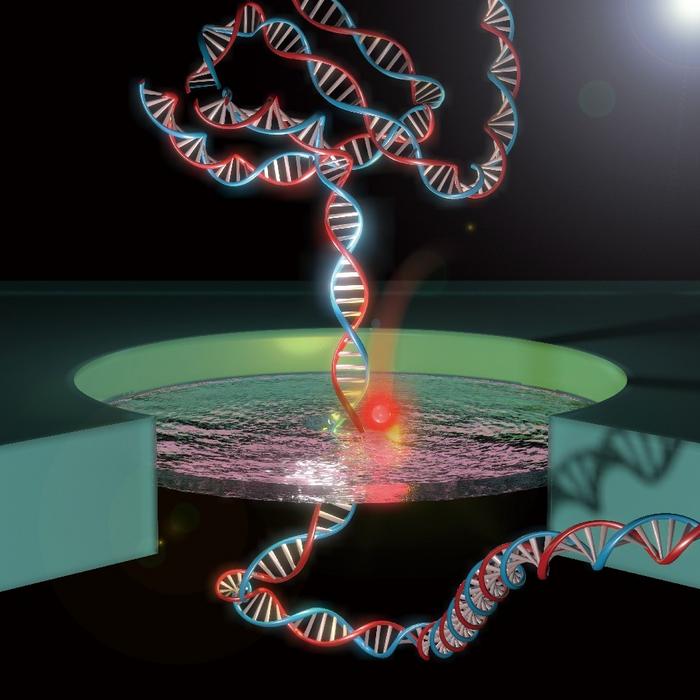
Researchers at Osaka University have made a significant advancement in the field of nanotechnology with the development of an innovative nanogate that can be dynamically controlled by applied electrical signals. This nanogate operates at the nanoscale and mimics the behavior of macroscopic gates in controlling the passage of molecules. By harnessing electricity, scientists can open or close the tiny gate, allowing for selective translocation of ions and other species, presenting exciting possibilities for applications in biochemical sensing, controlled chemical reactions, and beyond.
The design of this state-of-the-art nanogate features a pore etched into a silicon nitride membrane, a configuration that serves as an effective barrier between two liquid environments. In this groundbreaking exploration, researchers have positioned this membrane within a flow cell where solutions are allowed to flow through from either side. By utilizing electrodes embedded into the chip, they are able to apply varying voltages. Measuring the ionic current through the pore reveals how ions move between the solutions, acting as a real-time indicator of the gate’s performance.
One of the most fascinating aspects of the research is its demonstration that the ionic current is directly influenced by the type of ions in the solutions flanking the membrane. As voltage is manipulated, the ions transition through the tiny pore. Notably, this ionic transport can be finely controlled, allowing for the precise precipitation and dissolution of metal compounds within the pore itself. This capability opens new doors for experimental setups where researchers can monitor and manipulate ionic pathways dynamically.
The lead author of the study, Makusu Tsutsui, explained a critical observation: the application of a negative voltage induces the formation of precipitates within the pore, thereby narrowing the diameter and resulting in reduced ionic current. Conversely, by reversing the polarity of the voltage, these precipitates are encouraged to dissolve, effectively enlarging the pore and allowing for an increased ionic flow. This toggle between blocking and unblocking the nanogate showcases an unprecedented level of control in ionic transport, a feature that is vital for various applications in nanotechnology and materials science.
Moreover, under certain conditions, the formation of a blocking precipitate generates a high rectification ratio. This ratio serves as an indicator of how adeptly ions can travel in a singular direction, which is particularly promising for the development of nanofluidic devices. The ability to function as both a rectifier and a memristor—showcasing memory effects based on its voltage and current relationship—places this nanogate at the frontier of electrical engineering and molecular sensing technology.
Further emphasizing its versatility, the nanogate is capable of supporting specific in-pore reactions that extend to biomolecule detection. By utilizing individual DNA molecules as a probe, the system is shown to provide distinct electrical output signals as these molecules traverse through the pore. This aspect underscores the potential of the nanogate not only for sensing applications but also for exploring new complexes in biochemistry and molecular biology.
Mitsui remarked on the potential ramifications of this technology, particularly its ability to tailor pore sizes for specific analytes instantaneously prior to conducting measurements. This capacity could revolutionize fields ranging from biomedical diagnostics to drug delivery systems, where selective permeability and immediate responsiveness to chemical environments are critical.
The implications of this research extend beyond immediate applications. As the field moves towards integrating nanotechnology with advanced materials science, the controlled electrical manipulation of ionic environments opens avenues for developing new compounds that could benefit various sectors, including pharmaceuticals, environmental monitoring, and nanomedicine. With ongoing research, the group envisions the future of nanogates as integral components of electrochemical devices that pivot towards practical and innovative uses in everyday technology.
The findings of this study represent a significant leap in leveraging electrical signals for chemical control at a minuscule scale. The manipulation of ionic currents through ingeniously fabricated nanopores could lead to pioneering advancements across multiple scientific disciplines. By synthesizing engineering with chemistry, this research paints an optimistic picture of a future where nanotechnology enables groundbreaking innovations.
Moreover, the intricate relationship between electrical impulses and chemical behaviors seen in the nanogate supports a growing body of work that aims for greater synergy between synthetic science and material construction. With this remarkable technology, researchers hope to graduate from conceptual frameworks to practical applications that enhance the sophistication of electronic devices.
In summary, the new nanogate technology cultivated by Osaka University researchers holds the promise of reshaping modern electrochemical electronics and sensing applications. Its potential to control the flow of ions and other molecules with precise voltage adjustments represents not merely a scientific curiosity but a pivotal development that could influence various industries and research fields for years to come. As scholarship continues to unfold in this exciting domain, anticipation builds around the tangible impacts and transformative applications that arise from such advancements in nanotechnology.
Subject of Research: Nanogate technology for controlling ionic transport
Article Title: Transmembrane voltage-gated nanopores controlled by electrically tunable in-pore chemistry
News Publication Date: 5-Feb-2025
Web References: Nature Communications DOI
References: N/A
Image Credits: Credit: Makusu Tsutsui
Keywords
Tags: biochemical sensing applicationscontrolled chemical reactionsdynamic nanogate technologyelectrical control of nanoporesflow cell design in nanotechnologyinnovative nanomaterials researchionic current measurementnanoscale gate mechanismsnanotechnology advancementsreal-time performance indicatorsselective ion translocationsilicon nitride membranes





